Last Updated on May 2, 2021 by Danny
Hand drums have played an essential role in human civilization since the dawn of time. They have religious, ceremonial, and cultural significance. Some were meant to appease the gods, while others were a form of protest against oppressors. Each country, why each region in each country, has developed its own hand drum.
With the music industry embracing world percussion instruments, many previously unknown hand drums are becoming well known. It is therefore crucial for musicians, especially percussionists, to know about them. Here is everything you need to know about these hand drums!
Types of Hand Drums of various regions and countries with pictures
Africa: Djembe

The djembe is a large gobbled-shaped hand drum that the Mandé people of west Africa created. The drum is traditionally made out of wood and has a goatskin head. However, nowadays you can find djembes made from synthetic materials. The djembe can be played with two hands or with one hand and a stick.
The djembe is incredibly loud, thereby allowing it to cut through other instruments and sounds with ease. It also has a wide tonal range, allowing it to create powerful lows and shrill highs. Drummers favor it as it is incredibly portable for such a loud instrument.
From Latin America Peru: Cajon

The Cajon is, in essence, a wooden box, even the word cajon even means box in Spanish. Drummers sit on top of the Cajon and strike the front while the backside has a hole to help with resonance. Some modern cajons also have guitar strings or snares attached to them to improve the sound. There are even cajons with jingles in them.
This drum originated in Peru, where slaves in port cities used to play on wooden shipping crates as the Spanish colonists had banned drums in the region. The Cajon also developed in Cuba at around the same time due to similar reasons. Cajons have been used in various music styles like pop, fusion music, and flamenco.
If you are interested in Cajons, Take a look at some of the best Cajon for the money.
Brazil: Pandeiro
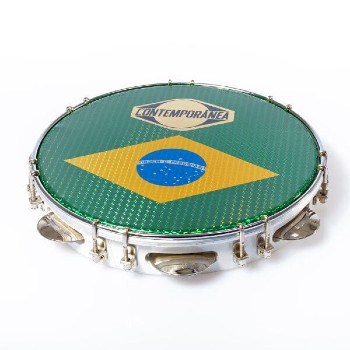
The pandeiro is a frame drum with metal jingles (platinelas) that is quite similar to a tambourine. The jingles are cupped in the pandeiro, which allows them to create a crisper, drier, and less sustained tone compared to the tambourine. This hand drum is commonplace in capoeira, coco, choro, and samba music.
Musicians hold it one hand and strike it with the other to make a sound. You can use your heel, palm, thumb, or fingertips to hit it; each has its tone. You could also shake the pandeiro or even run your finger across its head to produce a kind of drum roll.
Cuba: Conga and Bongos
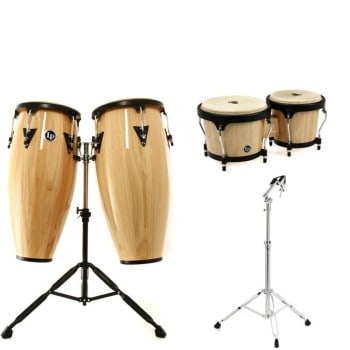
The conga is among the most popular Latin hand drums. It is a tall and narrow drum that was originally made of wooden staves that had been outfitted with calf skins.
Nowadays, you can get congas made of natural materials like wood or synthetic ones like fiberglass; you also get a wide choice of natural and synthetic heads. The natural ones have a much richer sound, while the synthetic ones have better projection.
While you can get congas as individual drums or as pairs, a traditional set of congas consists of three drums: a large Tumba drum, a mid-sized conga, and a smaller Quinto. As you would expect, the Tumba has a powerful low-end sound while the Quinto has a much higher tone. Sometimes there is an additional super Quinto that is tuned ever higher than the Quinto.
Another popular Cuban hand drum, bongos, is a set of two small open-bottomed drums made of wooden shells and calfskin heads, similar to the conga. Nowadays, you also get bongos made of synthetic heads.
Traditionally, bongoceros (bongo drummers) sit down and hold the bongos between their legs while playing. Bongos are globally famous and can be used as a lead instrument and even for solo performances.
India: Tabla

While India is home to many hand drums, none are as famous as the tabla. It is a common feature in not only classical Indian music but also in movies, holy rituals, and even modern songs. The tabla is a set of two drums consisting of one small wooden drum and a larger metallic drum.
The smaller wooden drum has a higher pitch and is placed to the drummer’s right; this drum is known as the Dayan (which literally means right). The larger metal drum is made from either copper or brass and has a much deeper sound. This drum is known as the bayan and is placed to the left of the drummer. Yes, bayan does mean left!
The drumheads are made of goatskin, which is then topped with a black patch made from rice paste, iron oxide, and a few other trace ingredients. The tabla is played using hand and finger techniques.
From Europe Ireland: Bodhran
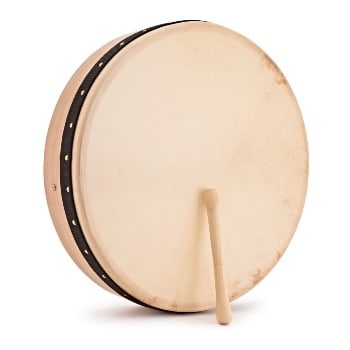
The Bodhran is a circular frame drum that slowly grew in popularity with Irish music during the 1960s and 1970s. This hand drum evolved in the 1800s and was probably a result of musicians combining tambourines with various rural tools.
One side of the drum is open-ended and has a handle for musicians to hold it with. The other side of the drum has a membrane (traditionally goatskin), and musicians play on this side with their bare hands or a piece of wood. The musicians can control the pitch and timbre of the Bodhran by pressing the handle hand against the head.
Japan: Taiko
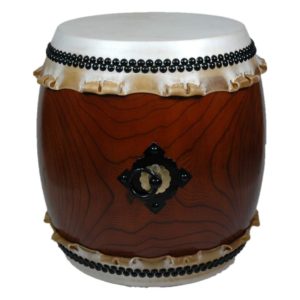
Taiko refers to the various Japanese barrel-shaped large-shelled drums that have lashed or tacked heads. These drums are usually played with sticks known as bachi. While the taiko is supposed to have mythological origins as per Japanese folklore, taiko actually originated due to Korean and Chinese cultural influences in the region. The taiko has been used for theatrical plays, military action, and communication.
When referring to specific taiko, the t of taiko changes to d. For example, the o-daiko is a large two-headed taiko used in folk festivals and Buddhist temples. Other examples of taiko include the shime-daiko, a two-head lashed taiko used in Noh drama, and gaku-daiko, a two-headed tacked drum that is hung in a complex circular frame in court music.
Middle East: Doumbek
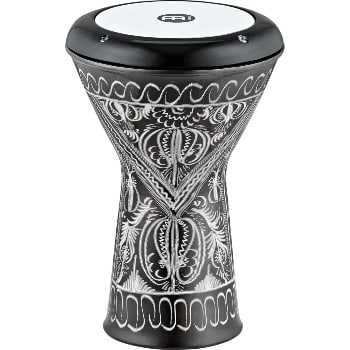
Doumbek is a small goblet-shaped hand drum that is extremely popular in the middle east. It is also known by various other names like dumbak, darbuka, Dombek, and tombek. This drum is held horizontally across one’s lap and played with hands and fingers. The tonal range is quite broad and dynamic.
While the drum originated in the middle east, it slowly spread to the Balkan states and other parts of the world. The spread of Doumbek was mainly due to the Ottoman Empire. The Ottoman empire loved the Doumbek, and they spread it to the various places they ruled.
There are many variations of the Doumbek based on location. Egyptian Doumbeks have cast-metal shells and have tunable mylar heads. This variant is capable of booming sounds, partially thanks to the rounded edges that let you pound without discomfort.
Turkish Doumbeks are similar to Egyptian ones but are made of thinner metal. They also have a sharply defined rim that gives them a resonating metallic sound. Sometimes, these Doumbeks even have cymbals/jingles attached to them for a more upbeat sound.
North America: hoop drum
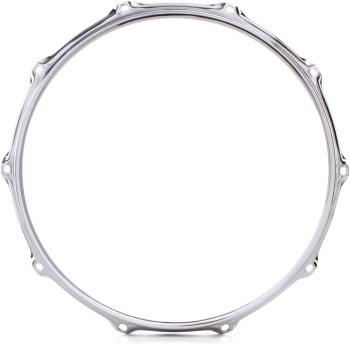
Hoop drums are circular frame drums that date back to Native Americans. They used to use it for games, communal events, performances, healing rituals, and even for spiritual communication. These drums are also known as buffalo drums as their head is made from buffalo hide. This hand drum comes in various sizes, and each size has its unique sound.
Thailand: Klong Yao
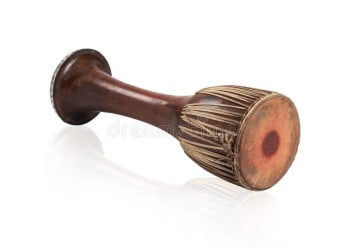
The Klong Yao is a long goblet-shaped drum that originated in Thailand. It is also known as Khawng Yao in nearby Laos. It is typically slung over the shoulder using a strap attached to the drum and played with bare hands. The shell is made from wood, and the drum head is typically made from water buffalo hide! There is usually a colorful skirt on the drum as decoration.
The Klong Yao is ubiquitous during festival parades in Thailand. Sometimes you can even encounter klong yaos that are 10 meters long in these parades. These are so gigantic that they have to be carried in trucks.
Hand drums are available in a variety of materials
While all handrums used to be made of natural materials, ones made from synthetic materials are becoming more common. Here are the advantages and disadvantages of both.
Natural materials
Hand drums made from natural materials are the original hand drums. They have a natural warm sound that is musically very rich. These drums are also incredible to look at; for example, the wooden grains of the djembe are beautiful.
The disadvantage to natural materials is that they are greatly affected by the surrounding environment. The temperature and humidity levels can alter the hand drum’s sound. These drums are also not as durable as ones made from synthetic materials.
Pros
- It has a warm and natural sound
- Looks beautiful
Cons
- It is not as durable as synthetic materials
- It can be affected by surrounding temperature and moisture
Synthetic materials
Drums made from synthetic materials typically have a much brighter and sharper sound compared to natural ones. It opens you to sounds that would have been impossible before the last century. You can also get them in unique and eye-catching colors.
Synthetic materials are also much more durable and are less likely to be affected by any fluctuations in the surrounding climate. They are more environmentally friendly, and no animal would have been harmed in their production. Hand drums made from synthetic materials are also cheaper than natural ones.
Pros
- Durable
- Have a bright and sharp sound
- It is not significantly affected by surrounding climate
- Environmental friendly and vegan option
Cons
- Do not look authentic
- Lack the charisma of natural materials
How much do hand drums cost?
Typically, a hand drum will cost from $15 to $150. The cost of the hand drum depends on the type of drum, its size, shell material, membrane material, whether they are hand-made, and its rarity. If you buy authentic, high-quality world percussion hand drums, they can set you back anywhere from $300 to a couple of thousand dollars!
For what type of music hand drum is used for?
Hand drums can be found in nearly all types of acoustic music. The sound range of hand drums allows them to work in many genres fluidly. For example, the Cajon can be found in genres like Afro-Peruvian, flamenco, and jazz. Another example would be bongos; this hand drum can be found in salsa and Latin jazz.
Hand drums also tend to hold a lot of cultural significance around the world. They form an essential part of many rituals and traditions of various countries and societies. For example, taiko is used in traditional theatres.
What materials should we prefer in hand drums?
The material you should prefer in hand drums mainly comes down to your needs.
If you want a natural-sounding drum that looks and feels authentic, you should get hand drums made from natural materials such as wood and animal hide. These will sound rich and are the “OG” hand drums. The specific choice of wood and hide comes down to what sound you want.
If you need a durable hand drum that can cut through sounds, look for ones made from synthetic materials. These have a bright sound that can be heard clearly by even the last line of the audience. Synthetic materials are also highly durable; they will last years and will require minimal tuning.
Which hand drum is good for a youngster or beginner percussionist?
Cajons, djembes, and congas are good hand drums for beginners and younger percussionists. These are affordable, relatively easy to learn, and work great with multiple music genres.
Cajon would be the best among these three as it is straightforward to learn; you can start dishing out great beats in a short time. Even if you do not have any proper musical knowledge, you can have tons of fun with it. As a bonus perk, it even doubles as a drum throne.